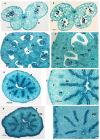Recovery and characterization of a Citrus clementina Hort. ex Tan. 'Clemenules' haploid plant selected to establish the reference whole Citrus genome sequence
- PMID: 19698121
- PMCID: PMC2747335
- DOI: 10.1186/1471-2229-9-110
Recovery and characterization of a Citrus clementina Hort. ex Tan. 'Clemenules' haploid plant selected to establish the reference whole Citrus genome sequence
Abstract
Background: In recent years, the development of structural genomics has generated a growing interest in obtaining haploid plants. The use of homozygous lines presents a significant advantage for the accomplishment of sequencing projects. Commercial citrus species are characterized by high heterozygosity, making it difficult to assemble large genome sequences. Thus, the International Citrus Genomic Consortium (ICGC) decided to establish a reference whole citrus genome sequence from a homozygous plant. Due to the existence of important molecular resources and previous success in obtaining haploid clementine plants, haploid clementine was selected as the target for the implementation of the reference whole genome citrus sequence.
Results: To obtain haploid clementine lines we used the technique of in situ gynogenesis induced by irradiated pollen. Flow cytometry, chromosome counts and SSR marker (Simple Sequence Repeats) analysis facilitated the identification of six different haploid lines (2n = x = 9), one aneuploid line (2n = 2x+4 = 22) and one doubled haploid plant (2n = 2x = 18) of 'Clemenules' clementine. One of the haploids, obtained directly from an original haploid embryo, grew vigorously and produced flowers after four years. This is the first haploid plant of clementine that has bloomed and we have, for the first time, characterized the histology of haploid and diploid flowers of clementine. Additionally a double haploid plant was obtained spontaneously from this haploid line.
Conclusion: The first haploid plant of 'Clemenules' clementine produced directly by germination of a haploid embryo, which grew vigorously and produced flowers, has been obtained in this work. This haploid line has been selected and it is being used by the ICGC to establish the reference sequence of the nuclear genome of citrus.
Figures






References
-
- Germanà MA. Doubled haploid production in fruit crops. Plant Cell, Tissue and Organ Culture. 2006;86:131–146. doi: 10.1007/s11240-006-9088-0. - DOI
-
- Leeuwen H, Monfort A, Zhang H, Puigdomènech P. Identification and characterisation of a melon genomic region containing a resistance gene cluster from a constructed BAC library. Microcolinearity between Cucumis melo and Arabidopsis thaliana. Plant Mol Biol. 2003;51(5):703–718. doi: 10.1023/A:1022573230486. - DOI - PubMed
-
- Hussain T, Tausend P, Graham G, Ho J. Registration of IBM2 SYN10 Doubled Haploid Mapping Population of Maize. Journal of Plant Registrations. 2007;1:81. doi: 10.3198/jpr2005.11.0414crs. - DOI
Publication types
MeSH terms
Substances
LinkOut - more resources
Full Text Sources

